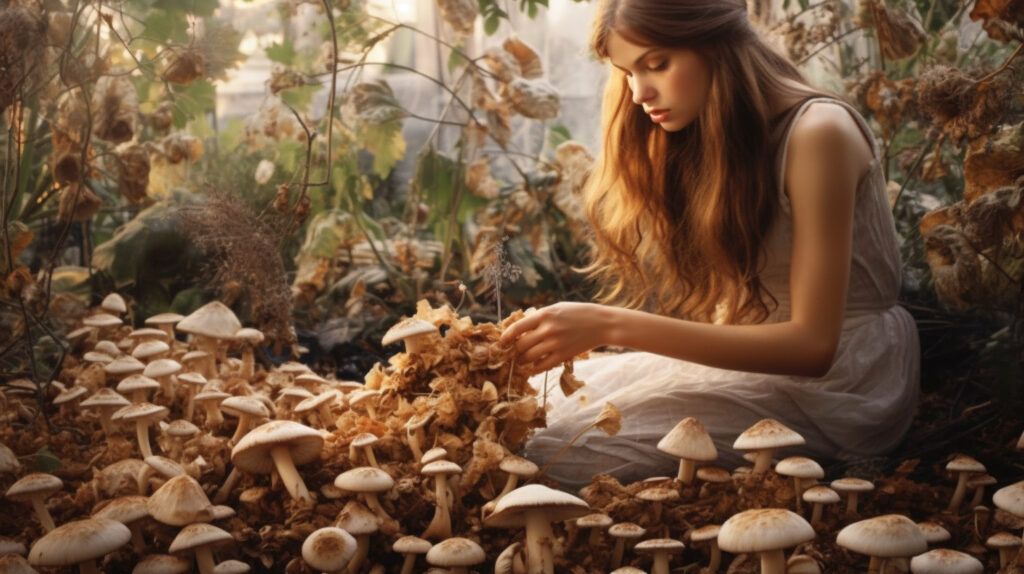TL;DR:
- Lion's mane mushrooms can be grown indoors at 60-75°F with diffused lighting and humidity above 90%.
- Use a hardwood-based substrate and inoculate with lion's mane spawn.
- Harvest mushrooms when tooth-like structures appear on the fruiting body.
- Lion's mane may improve brain health, immune system function, and memory.
- Consume fresh, dried, or powdered; cook similar to seafood.
- Side effects are rare but include itching, rashes, and gastrointestinal discomfort for a small miniroty.
- Forage for wild lion's mane mushrooms on decaying hardwood trees in late summer and fall, and store them in the fridge or dried in a cool, dark place.
- Modern research focuses on lion's mane's neuroprotective effects and treatment for cognitive impairments.
___
Welcome to the ultimate Lion's Mane Mushrooms guide that will unlock the secrets to cultivating, reaping health benefits, and enjoying scrumptious meals using this remarkable fungus! Today, we are taking you on an exciting journey to explore the world of Lion's Mane mushrooms, helping you grow your own supply at home and harness their potential to support your cognitive health, boost your immune system, and enrich your dietary life. Embrace your inner biohacker and become a part of our vibrant, health-driven, and like-minded community who also aspires to feel younger and think wiser. Embark on this journey with us and rediscover the magic of Lion's Mane mushrooms!
How to Grow Lion's Mane Mushrooms at Home
Growing lion's mane mushrooms (Hericium erinaceus) at home may seem like a daunting task, but with the right environment, equipment, and understanding, this fascinating and beneficial fungus can become a part of your indoor cultivation repertoire. From choosing the proper environment and substrate to maintaining perfect conditions and harvesting, let's explore a comprehensive guide to successfully growing lion's mane mushrooms at home.
What is the Right Environment for Growing Lion's Mane Mushrooms at Home
Lion's mane mushrooms can be grown both outdoors and indoors, but indoor cultivation offers greater control over environmental conditions (Stamets, 2000). To start, prepare a clean, well-ventilated area, preferably away from direct sunlight. The ideal temperature for lion's mane mushroom cultivation is between 60-75°F (15-24°C) (Stamets, 2005).
Creating the Perfect Substrate for Lion's Mane Mushroom Growth
Next, prepare a substrate for your mushrooms—a blend of hardwood sawdust or wood chips and supplements like wheat bran or rice bran, as lion's mane thrives on the cellulose in these materials (Stamets, 2000). Sterilize or pasteurize the substrate to eliminate competing organisms and to create a clean medium for growth.
Lion's Mane Mushrooms Spawn Selection and Inoculation Methods
Inoculate your prepared substrate with a lion's mane mushroom spawn. Purchase an appropriate spawn from a reputable supplier, like a grain spawn or plug spawn (Stamets, 2000) we suggest North Spore. Introduce the spawn into the substrate using either a layering or mixing technique, depending on the type of container used for cultivation.
Maintaining Proper Lion's Mane Mushrooms Growing Conditions (Humidity, Temperature, Lighting)
Proper temperature, humidity, and lighting are essential for the successful growth of lion's mane mushrooms. Maintain optimal temperature and humidity levels (60-75°F, 15-24°C) and ensure humidity stays above 90% (Stamets, 2000). Lighting should be diffused or indirect, as direct sunlight is not ideal for lion's mane mushroom growth.
What is the Life Cycle of Lion's Mane Mushrooms?
Understand the life cycle of these wonderful mushrooms to anticipate growth stages and potential issues. The lion's mane mushroom life cycle consists of the vegetative mycelial phase and the reproductive fruiting body phase. Typically, it takes 14-21 days after inoculation for the first signs of fruiting bodies to emerge (Stamets, 2000).
Monitoring and Troubleshooting Lion's Mane Mushroom Growth at Home
Periodically check on your lion's mane mushrooms and make adjustments as needed. If you notice issues such as low humidity, dry or contaminated substrate, address these promptly to ensure successful growth.
How to Harvest Homegrown Lion's Mane Mushrooms?
Harvest the lion's mane mushrooms once they reach maturity, characterized by tooth-like structures hanging from the fruiting body (Stamets, 2000). Gently twist or cut the mushrooms from the substrate, and enjoy the fantastic nutritional and medicinal benefits of these amazing fungi in your favorite recipes and wellness rituals.
References
Stamets, P. (2000). Growing Gourmet and Medicinal Mushrooms. Berkeley, California: Ten Speed Press.
Stamets, P. (2005). Mycelium Running. Berkeley, California: Ten Speed Press.
Lion's Mane Mushroom Benefits and How to Consume Them
What is the science behind Lion's Mane Mushroom health benefits?
Lion's mane mushrooms have gained popularity in recent years for their potential health benefits. Research suggests that these mushrooms may offer various advantages, specifically for brain health and the immune system (Lai et al., 2013). Let's dive into the exciting science-backed benefits of lion's mane mushrooms and learn how to incorporate them into your daily routine.
What effect does Lion's Mane Mushroom have on Brain and mental health support?
One of the most notable lion's mane mushroom benefits is their impact on brain health. Research has shown that lion's mane mushrooms contain bioactive compounds that stimulate the production of nerve growth factor (NGF), a protein essential for neuron growth and maintenance (Mori et al., 2009). This may result in improved cognitive function, better focus, and potentially reduced symptoms of anxiety and depression (Nagano et al., 2010).
What effect does Lion's Mane Mushroom have on Immune system support?
Another health benefit of lion's mane mushrooms is their capacity to support the immune system. These mushrooms contain various polysaccharides and beta-glucans, which have been shown to stimulate immune response and offer antioxidative and anti-inflammatory effects (Chen et al., 2012).
What effect does Lion's Mane Mushroom have on Memory enhancement and nerve growth promotion?
Due to lion's mane mushroom's influence on NGF, they may also help improve memory as well as promote nerve growth (Mori et al., 2008). This makes lion's mane mushrooms particularly interesting for individuals experiencing cognitive decline or seeking to improve their overall brain function.
How to safely consume lion's mane mushrooms?
Lion's mane mushrooms can be safely consumed in various forms, including fresh, dried, or powdered (used in Lion's Mane Supplements). When consuming fresh or dried mushrooms, it’s crucial to clean them properly before cooking to remove any debris.
Lion's mane mushroom supplement options and dosage guidelines
Lion's mane mushroom supplements are available in different forms, such as capsules, tablets, and extracts. The recommended dosage varies by product, so be sure to read and follow the label instructions on lion's mane mushroom dosage. Generally, it is suggested to take a daily dosage from 1–3g of lion's mane mushroom powder (Ulbricht et al., 2015).
However, as with any supplement, consult your healthcare provider before beginning to use lion's mane mushrooms, especially if you are pregnant or nursing, under medical treatment, or have known allergies.
References:
Chen, P., Yong, Y., Gu, Y., Wang, Z., Zhang, S., Lu, L., & Xu, H. (2012). Comparison of antioxidant and antiproliferation activities of polysaccharides from eight species of medicinal mushrooms. International journal of medicinal mushrooms, 14(2), 131-145.
Lai, P.-L., Naidu, M., Sabaratnam, V., Wong, K.-H., David, R. P., Kuppusamy, U. R., … & Malek, S. N. A. (2013). Neurotrophic properties of the Lion's mane medicinal mushroom, Hericium erinaceus (Higher Basidiomycetes) from Malaysia. International Journal of Medicinal Mushrooms, 15(6), 539-554.
Mori, K., Inatomi, S., Ouchi, K., Tuchiya, T., & Ohshima, T. (2009). Improving effects of the mushroom Yamabushitake (Hericium erinaceus) on mild cognitive impairment: a double-blind placebo-controlled clinical trial. Phytotherapy Research, 23(3), 367-372.
Mori, K., Obara, Y., Hirota, M., Azumi, Y., Kinugasa, S., Inatomi, S., & Nakahata, N. (2008). Nerve growth factor-inducing activity of Hericium erinaceus in 1321N1 human astrocytoma cells. Biological and Pharmaceutical Bulletin, 31(9), 1727-1732.
Nagano, M., Shimizu, K., Kondo, R., Hayashi, C., Sato, D., Kitagawa, K., & Ohnuki, K. (2010). Reduction of depression and anxiety by 4 weeks Hericium erinaceus intake. Biomedical Research, 31(4), 231-237.
Ulbricht, C., Abrams, T. R., Brigham, A., Ceurvels, J., Clubb, J., Curtiss, W., & Nguyen, Y. T. (2015). An evidence-based systemic review of lion's mane mushroom (Hericium erinaceus) by the Natural Standards Research Collaboration. Journal of Dietary Supplements, 12(2), 195-217.
Lion's Mane Mushroom Recipes and Cooking Tips
Before diving into the world of lion's mane mushroom recipes, you'll want to prepare and clean the mushrooms properly. To do this, brush off any dirt with a soft brush or a damp cloth. If the mushrooms appear clean, you can skip the washing step, as lion's mane mushrooms tend to retain a lot of water when washed (Bartholomew, A., 2017).
Now that your lion's mane mushrooms are prepped and ready to cook, let's explore some popular dishes and recipes where these fantastic fungi can truly shine:
- Sautéed Lion's Mane Mushrooms: Sauté the mushrooms in oil or butter with some garlic for a simple yet delicious dish. Their texture is similar to crab or lobster when cooked, making them a perfect addition to seafood dishes or a vegan alternative for that succulent meaty feel.
- Lion's Mane Mushroom Soup: Blend cooked lion's mane mushrooms with onions, garlic, vegetable stock, and seasoning for a creamy and satisfying soup that's packed with health benefits.
- Lion's Mane Mushroom Risotto: Incorporate chopped lion's mane mushrooms into a risotto for an earthy, umami-rich flavor and add a unique texture to this classic Italian dish.
To make lion's mane mushroom tea, simply steep dried lion's mane mushroom in hot water for 3-5 minutes. Strain the tea and sweeten it with honey or your preferred sweetener. You can also find lion's mane mushroom tea bags or extract powder for a more convenient option.
The key to preserving lion's mane mushrooms' texture and flavor is to cook them on medium to high heat, which helps to maintain their unique crab-like texture and earthy taste. When sautéing, make sure not to overcrowd the pan; this will promote even cooking and prevent the mushrooms from becoming soggy.
For those with dietary restrictions or looking for vegan options, experiment with substituting lion's mane mushrooms in recipes that call for meat or seafood. This versatile fungus can be used to enrich a variety of dishes, such as pasta, tacos, and even pizza toppings.
Immerse yourself in the world of lion's mane mushroom recipes and cooking tips to take advantage of their remarkable health benefits while satisfying your taste buds in the process. These fungi are a flavorful and nutritious addition to your culinary repertoire, so be sure to get creative in the kitchen to make the most of their potential.
Reference
Bartholomew, A. (2017). The mushroom cookbook. Adams Media.
What are the Side Effects and Safety Precautions for Lion's Mane Mushroom Consumption?
With the increasing popularity of lion's mane mushrooms, it's essential to understand any potential side effects and take necessary safety precautions for a positive experience. Lion's mane mushroom side effects are generally rare and mild, but they may still pose risks for certain individuals.
What are the potential side effects of lion's mane mushroom consumption?
While most people can safely consume lion's mane mushrooms, some may experience side effects such as itching, rashes, or gastrointestinal discomfort (Friedman, 2015). These reactions are generally mild. If you notice any adverse effects, it's vital to stop using lion's mane products and consult with a healthcare provider.
Are there Lion's Mane Mushroom Allergy and intolerance risks?
Lion's mane mushrooms could cause an allergic reaction in some individuals. Potential symptoms include skin rashes, difficulty breathing, and swelling. If you suspect an allergy to lion's mane mushrooms, seek medical attention immediately.
Safe dosages and precautions for various forms of lion's mane mushroom products
Although there is no official recommended dosage for lion's mane mushroom products, research suggests that a daily intake of 1000-3000 mg of lion's mane mushroom extract is safe for most people (Nagano et al., 2010). It's important to follow the product's label instructions and speak with a healthcare provider before starting any new supplement.
Toxicity concerns and ensuring lion's mane mushroom product safety
Lion's mane mushrooms are generally considered nontoxic. However, it's essential to source your lion's mane products from reputable companies to ensure the absence of contaminants, pesticides, or other harmful substances. Additionally, be cautious while foraging for wild lion's mane mushrooms, as some lookalikes may be toxic.
When to consult a healthcare provider about lion's mane mushroom consumption
If you're considering incorporating lion's mane mushrooms into your diet or supplement regimen, it's wise to consult with a healthcare professional, especially if you're pregnant, breastfeeding, or have pre-existing medical conditions. A healthcare provider can help you make an informed decision and provide guidance on safe and effective use.
How to Identify, Forage, and Store Wild Lion's Mane Mushrooms
How to Identify Lion's Mane Mushrooms and their common habitats
Lion's mane mushrooms (Hericium erinaceus) are distinctive, with their white, icicle-like spines, usually found growing on decaying hardwood trees. These mushrooms can be foraged between late summer and fall in North America, Europe, and Asia (Chen et al., 2020). Some common habitats include forests with beech, oak, or maple trees. When foraging for lion's mane, make sure you have a reliable field guide to help you with your identification process.
Tips for foraging wild lion's mane mushrooms
Foraging wild lion's mane mushrooms can be rewarding and fun. Here are some tips to help you find and harvest them:
- Use a field guide or a knowledgeable expert to confirm the identification of lion's mane mushrooms to avoid fatal mistakes.
- Carry a knife or scissors to cleanly cut the mushroom off the tree, leaving a small section of the stem behind to promote regrowth.
- Do not take every mushroom you find. Harvest only healthy, mature specimens and leave some for nature's sake (so they can spore!) and other foragers.
- Make sure you have permission to forage on public or private lands.
How to clean and preserve wild lion's mane mushrooms
Once you've harvested your lion's mane mushrooms, gently brush off any dirt or debris with a soft brush. You can rinse them under cold water if needed, but do so sparingly as they can easily absorb moisture.
To preserve your wild lion's mane mushrooms, you can dry them in a food dehydrator or an oven set at a low temperature until they are completely dry. This can take several hours. Another option is slicing the mushrooms thinly and placing them on a wire rack in a well-ventilated area for a few days.
What is a safe storage method for fresh and dried lion's mane mushrooms?
To store fresh lion's mane mushrooms, place them in a paper bag or wrap them in a damp cloth and refrigerate them for up to a week (Waldrop et al., 2019). Dried lion's mane mushrooms can be stored in an airtight container in a cool, dark place for up to a year.
How do I recognize lion's mane mushroom lookalikes and avoid potential hazards?
There are few true lookalikes for lion's mane mushrooms, but a few species may be mistaken for them, including Bear's Head Tooth (Hericium americanum) and Comb Tooth (Hericium coralloides), which are also edible and share similar features. However, it is essential to confirm your identification with a trusted field guide or experienced forager before consuming any wild mushrooms.
Remember, always practice responsible and safe foraging to protect yourself and the environment.
References:
Chen, X.-L., She, Y.-H., Zhou, S.-L., & Li, Y. (2020). The genus Hericium: Distribution and nutritional value. Fungal diversity, 104(1), 269-277.
Waldrop, B., Swick, R., & Jayalatharachchi, S. (2019). Mushroom shelf life extension using modified atmosphere packaging. Journal of Food Quality, 2019.
Lion's Mane Mushroom History and Modern Research
Historically, lion's mane mushrooms, also known as Hericium erinaceus, have been highly valued for their health-promoting properties across various cultures. In traditional Chinese medicine, these mushrooms have been used to stimulate brain function, improve memory, and enhance overall cognitive health (Wong, Gao, & Ng, 2012). Additionally, ancient Japanese cultures have embraced lion's mane as a natural remedy for digestive health and as a culinary delicacy.
In the realm of modern research, scientific studies have begun to support the long-held beliefs about lion's mane mushrooms' medicinal properties (Lakhanpal & Rana, 2005). The primary focus of these studies has been on understanding how lion's mane stimulates nerve growth factors (NGF) to improve brain and mental health (Mori, Inatomi, Ouchi, Azumi, & Tuchida, 2009). Researchers attribute the neuroprotective effects of the mushroom to two key components: hericenones and erinacines (Mori et al., 2008).
These compounds have been found to help with memory function by stimulating NGF synthesis, promoting nerve cell growth, and facilitating communication between neurons (Bai, Tangy, & Tsai, 2017). Consequently, lion's mane mushrooms have gained prominence in the medical community as a potential treatment for neurodegenerative conditions, such as Alzheimer's disease and other cognitive impairments (Lai et al., 2013).
Furthermore, lion's mane mushrooms have carved a unique place among other medicinal fungi. While other mushrooms like reishi and chaga may tout immune-supporting benefits, lion's mane's specific contributions to brain health make it a standout in the fungi kingdom for its potential impact on cognitive function.
The future of lion's mane mushroom research is certainly promising, leveraging current discoveries to explore other potential uses and applications. As science continues to uncover the fascinating properties of these mushrooms, we can anticipate increased understanding, novel treatments, and improved quality of life through the incorporation of lion's mane into our health and wellness routines.
References:
Bai, L., Tangy, Q., & Tsai, S. (2017). Lion's Mane, Hericium erinaceus and Tiger Milk, Lignosus rhinocerotis (Higher Basidiomycetes) Medicinal Mushrooms Stimulate Neurite Outgrowth in Dissociated Cells of Brain, Spinal Cord, and Retina: An In Vitro Study. International Journal of Medicinal Mushrooms, 18(11), 1047-1054.
Lai, P. Lee, U., & Yang N. (2013). Neurotrophic Properties of the Lion's mane Medicinal Mushroom, Hericium erinaceus (Higher Basidiomycetes) from Malaysia. International Journal of Medicinal Mushrooms, 15(6), 539-554.
Lakhanpal, T., & Rana, S. (2005). Medicinal and nutraceutical genetic resources of mushrooms. Plant Genetic Resources, 3(2), 288–303.
Mori, K., Inatomi, S., Ouchi, K., Azumi, Y., & Tuchida, T. (2009). Improving Effects of the Mushroom Yamabushitake (Hericium erinaceus) on Mild Cognitive Impairment: A Double-blind Placebo-controlled Clinical Trial. Phytotherapy Research, 23(3), 367-372.
Mori, K., Obara, Y., Hirota, M., Azumi, Y., Kinugasa, S., Inatomi, S., & Nakahata, N. (2008). Nerve Growth Factor-Inducing Activity of Hericium erinaceus in 1321N1 Human Astrocytoma Cells. Biological & Pharmaceutical Bulletin, 31(9), 1727-1732.
Wong, K. H., Gao, Y., & Ng, T. (2012). The Medicinal Properties of Fungi. In P. C. K. Cheung (Ed.), Handbook of Molecular and Cellular Microbiology(pp. 1099-1121). Taylor & Francis.
Conclusion
Congratulations on learning how to grow lion's mane mushrooms at home, cook them, consume them, forage for them and identify the proper lion's mane mushroom dosage! As a health-conscious adult who prioritizes your well-being, you value evidence-based information and want to invest in your health and fitness goals. By following the guidance in our blog, you can be sure you're choosing the best quality supplements, learning about the health benefits of lion's mane mushrooms, and promoting overall health and quality of life. Remember to stay connected with our health-conscious community and engage in discussions, events, and forums around health and wellness to find support and motivation from like-minded individuals. Be sure to check back in for new posts that will enlighten you about the historical and traditional use of lion's mane mushrooms in various cultures and the modern research behind health claims surrounding lion's mane mushroom consumption. Take action on your health today, and invest in our supplements to feel younger and think wiser!



